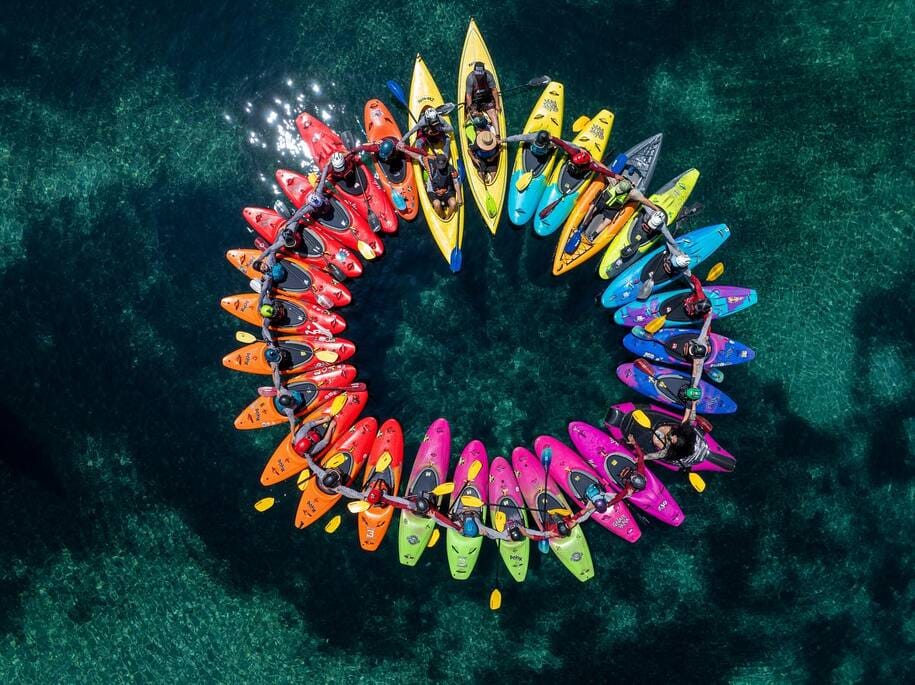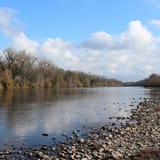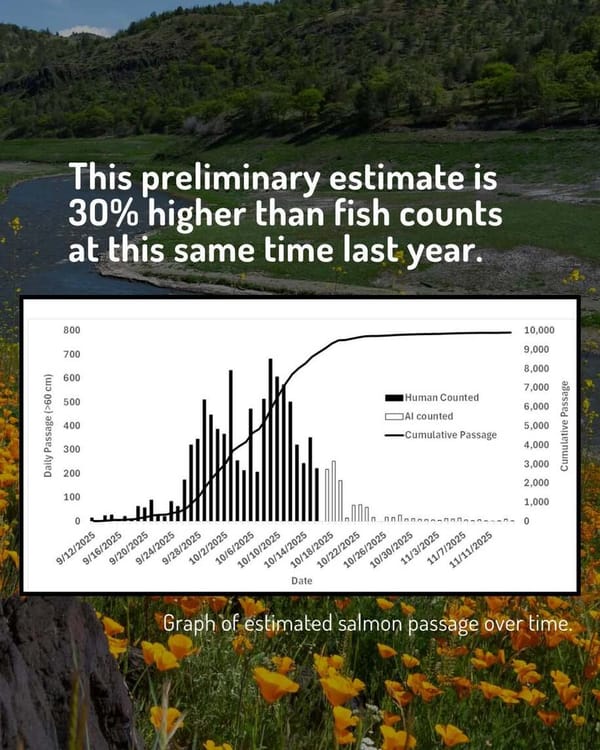Bill protecting Shasta and Scott River salmon is signed, first video taken of salmon above Keno Dam
However, there is some very welcome news regarding the Klamath River, where the removal of four dams was completed one year ago.

Commercial salmon fishing on California’s ocean waters has been closed for the past three years, while only a very limited recreational salmon season has been allowed on the ocean and three Central Valley rivers this year, due to the collapse of the Sacramento River and Klamath River fall-run Chinook salmon populations.
However, there is some very welcome news regarding the Klamath River, where the removal of four dams was completed one year ago. I spent many hours fishing the Klamath River and its largest tributary, the Trinity River, for salmon and steelhead before the four Klamath dams were removed. In fact, I experienced my best two days ever of salmon fishing anywhere on the Klamath River in September of 2012 and on the Trinity in September of 1986.
First, on last Friday, Native American Day in California, Governor Gavin Newsom signed California AB 263.
This bill, introduced by Assemblymember Chris Rogers on behalf of the Karuk Tribe, Yurok Tribe and California Coastkeeper Alliance, extends emergency water regulations for two key Klamath River tributaries, the Scott and Shasta Rivers, until January 1, 2031, or until permanent rules are adopted by the State, to protect struggling salmon populations.
“The Shasta and Scott rivers are currently under emergency regulations that took tribal voices and our state’s fisheries into consideration when they were developed,” said Assemblymember Rogers in a statement after the bill passed by the State Legislature in September. “Maintaining minimum flows on these tributaries will help the critical salmon restoration projects in the Klamath watershed continue to flourish. The temporary flow requirements maintained by AB 263 will provide certainty to farmers, fishermen, and tribal communities alike.”
“AB 263 was introduced in partnership with the Karuk Tribe, California Coastkeeper Alliance, and the Pacific Coast Federation of Fishermen’s Association (PCFFA). The bill would maintain river flows for at-risk salmon runs on two critical Klamath River tributaries – the Scott and Shasta Rivers,” Rogers explained. “Flow minimums were set by the State Water Board during the drought emergency declared by Governor Gavin Newsom in 2021 and, under this legislation, would stay in place until the Board promulgates long term flow rules. Amendments taken in the legislative process added a five year sunset date and a requirement for the State Water Board to hold an annual meeting to gather feedback from local stakeholders.”
Rogers noted that most of the wild Chinook salmon found in the Klamath River are born in the Shasta River. The Shasta River features cold water flows that drain the Mount Shasta Glacier.
The Scott River is also a significant producer of Coho salmon. In fact, the majority of the wild Southern Oregon/Northern California Coho salmon, a state and federally endangered species), spend part of their lifecycle in the Scott River. So these two rivers are critical to restoring salmon in California.
Joseph James, the Chair of the Yurok Tribe, hailed the passage and signing of the bill in a statement.
“The passage of AB 263 is a critical step toward protecting the lifeblood of our people — the Klamath River and its salmon. Tribes have fought to protect our water, fish, and culture, and this bill extends the safeguards we need while long-term flow rules are developed. This is real progress for the health of the river and everyone who depends on it,” said James.
“Klamath dam removal was just the first step in rebuilding our salmon fisheries,” said Karuk Chairman Russell ‘Buster’ Attebery. “We must protect flows in key salmon nurseries like the Scott and Shasta Rivers.”
Fishing organizations also celebrated the passage and signing of AB 237.
“To improve conditions for fish, sufficient flows instream are necessary,” said Angelina Cook, Restoration Associate with the California Sportfishing Protection Alliance. “Yet lack of enforceable regulations render California’s rivers vulnerable to dewatering. AB 263 establishes measurable thresholds which empower agencies to limit excessive water withdrawals. Passage of AB 263 is a significant step to reverse trends toward extinction of a keystone species in the third most productive salmon-bearing river in the contiguous western United States.”
On the same day, Newsom signed AB 977 by Assemblymember James C. Ramos (D-San Bernardino), a bill that directs California State University (CSU) to work with tribes towards establishing three tribal burial sites on CSU-owned land for the burial of Native American human remains, addressing “a critical need in the state’s repatriation efforts.” The Governor also signed AB 1369 by Assemblymember Ramos that clarifies students’ rights to wear traditional tribal regalia at high school graduations.
“Native American Day is a celebration of Native culture and achievements, an acknowledgment of what Native peoples have endured, and a day to honor their resilience and all that they’ve protected. Today’s legislation reaffirms our work to address historic wrongs and furthers the state’s promise to tribes of inclusion and accountability,” said Newsom.
However, it must be pointed out that Newsom continues to move forward with the Delta Tunnel and Sites Reservoir projects and Big Ag-backed voluntary agreements that are strongly opposed by the Winnemem Wintu Tribe, Shingle Springs Band of Miwok Indians and other tribes and tribal organizations.
Second, in more good news about the Klamath River and its tributaries, a video camera operated by the Oregon Department of Fish and Wildlife (ODFW) captured a Chinook salmon ascending the fish ladder at Keno Dam on the upper Klamath River on Sept. 24. This was the first picture of a salmon ascending the upper bays of the ladder since four hydroelectric dams were removed on the Klamath River last year, according to a press statement from the CDFW.
“It's a positive step for salmon because the majority of spawning habitat in the Oregon portion of the upper Klamath basin is above Keno Dam, Link River Dam, and Upper Klamath Lake,” the ODFW wrote.”While salmon were observed on the Keno Dam fish ladders last year, this is the first image of a salmon passing the dam, with the video showing a salmon leaping the last pool of the ladder to the exit of the dam.”
The cameras had been installed by ODFW and the Bureau of Reclamation just one day prior, Sept. 24, as part of efforts to monitor Chinook salmon migrating above Keno and Link River dams, the agency noted.
"Salmon are again reminding us of their resiliency as they return to a portion of river basin that hasn't seen salmon for more than 100 years," said ODFW Watershed Manager Phil Milburn. "That salmon have so quickly shown us they can pass this key barrier renews our sense of optimism for this population and comes after years of work by Tribes, agencies, and other partners."
"Oregon has high standards for fish passage and it will take some work for Keno Dam to meet those standards and ensure enough salmon can get to historic habitat," Milburn stated. "We are already working with partners including the Bureau of Reclamation to improve fish passage."
The ODFW said the detection at Keno Dam closely follows the first confirmation of the year that fall-run Chinook salmon are again returning to Oregon's portion of the Klamath River. On Tuesday, Sept. 23, 2025, a Chinook was detected on another ODFW video system on a tributary of the Klamath River a few miles downstream of Keno Dam.
“While four hydroelectric dams were removed from the Klamath River last year, Keno Dam and Link River Dam remain in operation. Both provide water for irrigation purposes and Keno Dam is also necessary for flood control in the region. Both dams are currently managed by the Bureau of Reclamation,” the agency pointed out.
“Passage above Keno Dam is just one obstacle in their long migration to historic spawning grounds and salmon will face additional challenges. They also need to navigate Link River Dam (at the outlet of Upper Klamath Lake), swim through Upper Klamath Lake and find suitable spawning habitat and a mate in the hundreds of miles of streams that enter the lake. Upper Klamath Lake's nutrient rich shallow water, poor water quality during certain times of year and unscreened diversions throughout the Basin will be a challenge for salmon,” the ODFW added.
As fall-run Chinook salmon return to Oregon's portion of the Klamath River this year, the ODFW, with its tribal, state and federal government partners, said it will again monitor for spawning in this stretch of the river.
In 2024, more than 500 adult fall Chinook were confirmed to have spawned in habitat in the previous hydroelectric reach below Keno Dam. “That was the first confirmed successful reproduction of Chinook salmon in Oregon's portion of the Klamath River Basin in over 100 years,” the ODFW concluded.
The video is available here: www.youtube.com/...
Data from the Pacific Fishery Management Council’s Review of 2024 Ocean Salmon Fisheries, published in February of this year, documents the salmon’s return to the Klamath above the former dam sites in California and Oregon in the fall of 2024
“Newly available mainstem and tributary habitats were occupied by salmon following dam removal,” the PFMC reported. “The estimated run size in the Klamath mainstem and its tributaries from Iron Gate (California) to Keno Dam was 1,494 adults and 151 jacks in 2024.”
Hopefully, even more salmon and steelhead will return to the Klamath River above the former dam sites this fall.
Here are the latest salmon counts on the Klamath River and tributaries from the California Department of Fish and Wildlife. The CDFW annually operates adult fish counting facilities on the Shasta River, Scott River, Bogus Creek, Jenny Creek and Shovel Creek:
The Shasta River station began operating on August 28, 2025 and 4,042 adult Chinook Salmon, 0 adult Coho Salmon and 128 adult (>16”) steelhead (Oncorhynchus mykiss) have been observed through October 2, 2025.
The Bogus Creek station began operating on September 26, 2025. However, there was an issue with the video data storage which was fixed on September 30, 2025 and video footage from September 26-29 has not been reviewed and may be added later if it is accessible. 8 adult Chinook Salmon, 0 adult Coho Salmon and 0 adult (>16”) steelhead have been observed through October 2, 2025.
The Scott River station began operating on September 23, 2025 and 183 adult Chinook Salmon, 0 adult Coho Salmon and 5 adult (>16”) steelhead have been observed through October 2, 2025.
The Jenny Creek station began operating on September 19, 2025 and 11 adult Chinook Salmon, 0 adult Coho Salmon and 0 adult (>16”) steelhead have been observed through October 2, 2025.
The Shovel Creek station began operating on September 15, 2025 and 2 Chinook Salmon, 0 Coho Salmon, and 0 adult (>16”) steelhead have been observed as of October 2, 2025.




